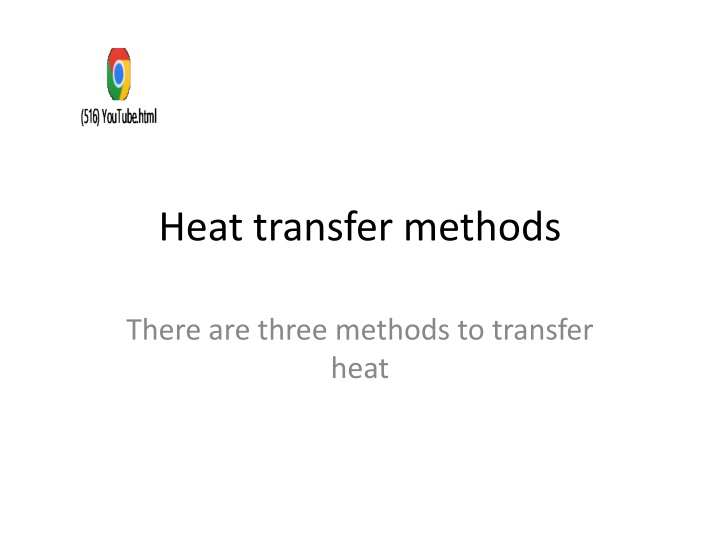
Heat Transfer Methods: Conduction, Convection, Radiation
Learn about the three main methods of heat transfer - conduction, convection, and radiation. Understand how heat flows through different mediums and how each method works to transfer thermal energy efficiently.
Download Presentation

Please find below an Image/Link to download the presentation.
The content on the website is provided AS IS for your information and personal use only. It may not be sold, licensed, or shared on other websites without obtaining consent from the author. If you encounter any issues during the download, it is possible that the publisher has removed the file from their server.
You are allowed to download the files provided on this website for personal or commercial use, subject to the condition that they are used lawfully. All files are the property of their respective owners.
The content on the website is provided AS IS for your information and personal use only. It may not be sold, licensed, or shared on other websites without obtaining consent from the author.
E N D
Presentation Transcript
Heat transfer methods There are three methods to transfer heat
1. Conduction: Conduction occurs when two object at different temperatures are in contact with each other. Heat flows from the warmer to the cooler object until they are both at the same temperature. Conduction is the movement of heat through a substance by the collision of molecules. At the place where the two object touch, the faster-moving molecules of the warmer object collide with the slower moving molecules of the cooler object. As they collide, the faster molecules give up some of their energy to the slower molecules. The slower molecules gain more thermal energy and collide with other molecules in the cooler object. This process continues until heat energy from the warmer object spreads throughout the cooler object. Some substances conduct heat more easily than others. Solids are better conductor than liquids and liquids are better conductor than gases. Metals are very good conductors of heat, while air is very poor conductor of heat. You experience heat transfer by conduction whenever you touch something that is hotter or colder than your skin e.g. when you wash your hands in warm or cold water.
convection In liquids and gases, convection is usually the most efficient way to transfer heat. Convection occurs when warmer areas of a liquid or gas rise to cooler areas in the liquid or gas. As this happens, cooler liquid or gas takes the place of the warmer areas which have risen higher. This cycle results in a continuous circulation pattern and heat is transferred to cooler areas. You see convection when you boil water in a pan. The bubbles of water that rise are the hotter parts of the water rising to the cooler area of water at the top of the pan. You have probably heard the expression "Hot air rises and cool air falls to take its place" - this is a description of convection in our atmosphere. Heat energy is transferred by the circulation of the air.
Radiation Both conduction and convection require matter to transfer heat. Radiation is a method of heat transfer that does not rely upon any contact between the heat source and the heated object. For example, we feel heat from the sun even though we are not touching it. Heat can be transmitted through empty space by thermal radiation. Thermal radiation (often called infrared radiation) is a type electromagnetic radiation (or light). Radiation is a form of energy transport consisting of electromagnetic waves traveling at the speed of light. No mass is exchanged and no medium is required. Objects emit radiation when high energy electrons in a higher atomic level fall down to lower energy levels. The energy lost is emitted as light or electromagnetic radiation. Energy that is absorbed by an atom causes its electrons to "jump" up to higher energy levels. All objects absorb and emit radiation. ( Here is a java applet showing how an atom absorbs and emits radiation) When the absorption of energy balances the emission of energy, the temperature of an object stays constant. If the absorption of energy is greater than the emission of energy, the temperature of an object rises. If the absorption of energy is less than the emission of energy, the temperature of an object falls.


















